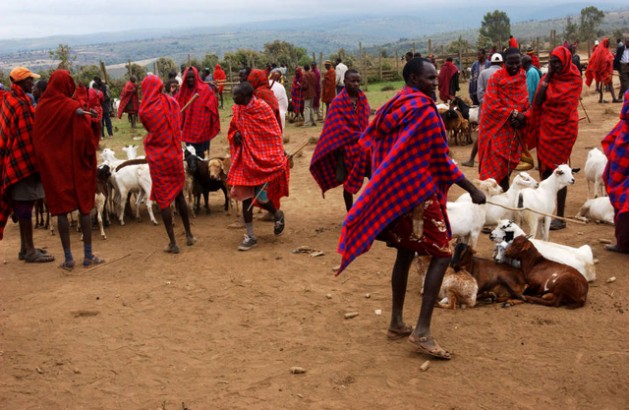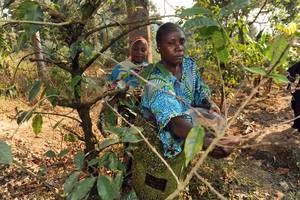Rights of Indigenous Peoples ‘Critical’ to Combat Climate Change
INDIGENOUS RIGHTS, 1 Aug 2016
Baher Kamal – Inter Press Service-IPS
 25 Jul 2016 – No longer it is about restoring the legitimate rights of over 370 indigenous peoples spread across 70 countries worldwide, many of them living in dire situation, but now about their central, critical role in combating climate change.
25 Jul 2016 – No longer it is about restoring the legitimate rights of over 370 indigenous peoples spread across 70 countries worldwide, many of them living in dire situation, but now about their central, critical role in combating climate change.
Victoria Tauli-Corpuz, the United Nations Special Rapporteur on the Rights of Indigenous Peoples has relentlessly emphasized this new reality.
“Very few countries have so far made a clear commitment to a requirement in the Paris Climate Change Agreement that countries undertaking climate change activities should ensure the rights of indigenous peoples,” she says, while reminding of “the large number of violent deaths of people protecting their forests and rights to land in 2015 – the deadliest year for environmental defenders on record.”
“It’s a dire situation in terms of respect for the rights of indigenous peoples,” she told the participants in the United Nations Food and Agriculture Organisation’s Committee on Forestry (COFO) which met in the Italian capital on July 18-22.
“Indigenous peoples across the world experience the consequences of historical colonisation and invasion of their territories, and face discrimination because of their distinct cultures, identities and ways of life,” according to UN Special Rapporteur on the Rights of Indigenous Peoples.

Maasai pastoralists, who participate in a farmer field school, are selling animals at a local market in Narok, Kenya. Indigenous peoples have a key role to play in addressing climate change. Credit: FAO
On this, FAO stated that “Governments must do much more to provide the enabling conditions required for indigenous peoples, local communities, smallholders and their organisations to restore degraded landscapes and achieve climate change mitigation and adaptation in practice.”
Specifically, René Castro Salazar, FAO’s Assistant-Director General warned that the issue of indigenous rights to land and territories was ‘critical’ for the success of climate change initiatives.
“Unless we help indigenous peoples achieve secure land tenure and better governance, it will be very hard to achieve long-term solutions,” Castro Salazar said. “We are lagging behind, and we need to do more.”
Vast Carbon Stocks
A third of global forests are under some form of management by families, smallholders, local communities and indigenous peoples, and represent some of the most important carbon stocks in the world, FAO reported during the meeting. Government-recognised community forests alone hold an estimated 37.7 billion tonnes of carbon stock.

Agro-forestry farmers are tending to the crops in Kigoma, Tanzania. Forests are an integral part of the national agriculture policy with the aim of protecting arable land from erosion and increasing agricultural production. Credit: FAO
“Family smallholders, local communities and indigenous peoples have a key role to play in preserving these carbon stocks by reducing deforestation, managing forests sustainably and restoring tree cover as part of productive rural economies, particularly when they belong to strong producer organisations,” according to the UN agency.
In addition, an estimated 1.5 billion hectares of land hold potential for smallholder farmers to combine agriculture with trees.
“But failure to find the best way to engage with local stakeholders and align their interests with forest conservation can significantly compromise the chances of achieving carbon sequestration and mitigation targets.”
Greater Ownership
In an outcome statement issued at the close of the Rome meeting, participants urged governments to provide the enabling conditions required for local communities, indigenous peoples and local producers, “to manage larger territories, from securing and enforcing tenure rights to creating favourable business incentives and offering technical, financial and business extension services.”
They also called on global financing mechanisms, government programmes and private investors to direct investment and support towards local communities, indigenous peoples, smallholders and producer organisations.
Finally, they called for climate change initiatives “to shift towards giving greater ownership to local communities, indigenous peoples, smallholders and producer organisations and engaging them in participatory and qualitative assessment of the forest cover and trees on farms they manage.”
Livelihoods of Millions of People, Precarious
On the occasion of the Rome meeting, FAO issued a new study that helps to fill a significant knowledge gap on the presence and extent of forests and trees in the world’s drylands, where the food security and livelihoods of millions of people, already precarious, are increasingly being threatened by climate change.
The study’s preliminary findings show that trees are present with hugely varying densities on almost one-third of the world’s 6.1 billion hectares of drylands, which cover an area more than twice the size of Africa. Almost 18 per cent of this area contains forests.
An estimated 2 billion people, 90 per cent of whom are in developing countries, live in drylands. Recent studies have indicated the need to restore these areas to cope with the effects of drought, desertification and land degradation.
In particular, water availability in drylands is expected to decline further due to changes in climate and land use, the new study warns.
“Poor people living in remote rural areas will be most vulnerable to food shortages, which combined with violence and social upheaval, are already leading to forced migration in dryland regions in Africa and western Asia.”
Until now, there has been little statistically based knowledge on dryland trees –particularly those growing outside forests– despite their vital importance to humans and the environment, according to the study.
The leaves and fruit of trees are sources of food for people and fodder for animals; their wood provides fuel for cooking and heating and can be a source of income for poor households; trees protect soils, crops and animals from the sun and winds, while forests are often rich in biodiversity.
Drylands are divided into four aridity zones (see map): the dry sub-humid zone, is the least arid of the four zones and consists mostly of the Sudanian savanna, forests and grasslands in South America, the steppes of eastern Europe and southern Siberia, and the Canadian prairie.
Most dryland forests occur in this zone, as do some large irrigated, intensively farmed areas along perennial rivers; at the other extreme, the hyper-arid zone is the driest zone and it is dominated by desert – the Sahara alone accounting for 45 per cent, and the Arabian desert forming another large component.
Factbox
At a glance: some preliminary findings of the FAO Global Drylands Assessment:
- The global drylands contain 1.11 billion hectares of forest land, which is 27 per cent of the global forest area, estimated at approximately 4 billion hectares.
- Two-thirds of the drylands forest area can be defined as being dense, meaning it has closed canopies (i.e. a canopy cover greater than 40 per cent).
- The second most common land use in drylands is grassland (31 per cent), followed by forest (18 per cent) and cropland (14 per cent). The category other lands constitutes 34 per cent of the global drylands area.
- The least-arid zones have the most forest. The proportion of forest land is 51 per cent in the dry subhumid zone, 41 per cent in the semiarid zone, 7 per cent in the arid zone and 0.5 per cent in the hyperarid zone. The average crown cover density is ten times higher in the dry subhumid zone than in the hyperarid zone.
- Trees outside forests are present on 1.9 billion hectares of drylands (31 per cent of the global drylands area), if all land with more than 0 per cent crown cover is included. Thirty per cent of croplands and grasslands have at least some crown cover, as do 60 per cent of lands classified as settlements.
_______________________________________
Baher Kamal, Egyptian-born, Spanish national secular journalist. He is founder and publisher of Human Wrongs Watch. Kamal is a pro-peace, non-violence, human rights, harmonious coexistence defender among human beings and with Nature, with more than 43 years of professional experience. With these issues in sight, he covered practically all professional posts, from correspondent to chief editor of dailies and international news agencies.
DISCLAIMER: The statements, views and opinions expressed in pieces republished here are solely those of the authors and do not necessarily represent those of TMS. In accordance with title 17 U.S.C. section 107, this material is distributed without profit to those who have expressed a prior interest in receiving the included information for research and educational purposes. TMS has no affiliation whatsoever with the originator of this article nor is TMS endorsed or sponsored by the originator. “GO TO ORIGINAL” links are provided as a convenience to our readers and allow for verification of authenticity. However, as originating pages are often updated by their originating host sites, the versions posted may not match the versions our readers view when clicking the “GO TO ORIGINAL” links. This site contains copyrighted material the use of which has not always been specifically authorized by the copyright owner. We are making such material available in our efforts to advance understanding of environmental, political, human rights, economic, democracy, scientific, and social justice issues, etc. We believe this constitutes a ‘fair use’ of any such copyrighted material as provided for in section 107 of the US Copyright Law. In accordance with Title 17 U.S.C. Section 107, the material on this site is distributed without profit to those who have expressed a prior interest in receiving the included information for research and educational purposes. For more information go to: http://www.law.cornell.edu/uscode/17/107.shtml. If you wish to use copyrighted material from this site for purposes of your own that go beyond ‘fair use’, you must obtain permission from the copyright owner.